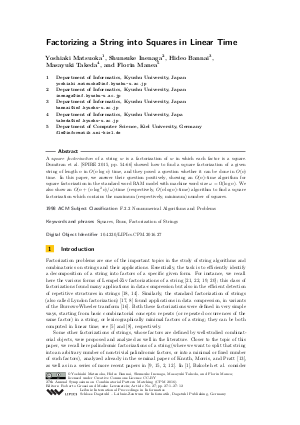Factorizing a String into Squares in Linear Time
Authors Yoshiaki Matsuoka, Shunsuke Inenaga, Hideo Bannai, Masayuki Takeda, Florin Manea
-
Part of:
Volume:
27th Annual Symposium on Combinatorial Pattern Matching (CPM 2016)
Part of: Series: Leibniz International Proceedings in Informatics (LIPIcs)
Part of: Conference: Annual Symposium on Combinatorial Pattern Matching (CPM) - License:
 Creative Commons Attribution 3.0 Unported license
Creative Commons Attribution 3.0 Unported license
- Publication Date: 2016-06-27
File

PDF
LIPIcs.CPM.2016.27.pdf
- Filesize: 445 kB
- 12 pages
Document Identifiers
Subject Classification
Keywords
- Squares
- Runs
- Factorization of Strings
Metrics
- Access Statistics
-
Total Accesses (updated on a weekly basis)
0Document
0Metadata
Abstract
A square factorization of a string w is a factorization of w in which each factor is a square. Dumitran et al. [SPIRE 2015, pp. 54-66] showed how to find a square factorization of a given string of length n in O(n log n) time, and they posed a question whether it can be done in O(n) time. In this paper, we answer their question positively, showing an O(n)-time algorithm for square factorization in the standard word RAM model with machine word size omega = Omega(log n). We also show an O(n + (n log^2 n) / omega)-time (respectively, O(n log n)-time) algorithm to find a square factorization which contains the maximum (respectively, minimum) number of squares.
Cite As Get BibTex
Yoshiaki Matsuoka, Shunsuke Inenaga, Hideo Bannai, Masayuki Takeda, and Florin Manea. Factorizing a String into Squares in Linear Time. In 27th Annual Symposium on Combinatorial Pattern Matching (CPM 2016). Leibniz International Proceedings in Informatics (LIPIcs), Volume 54, pp. 27:1-27:12, Schloss Dagstuhl – Leibniz-Zentrum für Informatik (2016)
https://doi.org/10.4230/LIPIcs.CPM.2016.27
BibTex
@InProceedings{matsuoka_et_al:LIPIcs.CPM.2016.27,
author = {Matsuoka, Yoshiaki and Inenaga, Shunsuke and Bannai, Hideo and Takeda, Masayuki and Manea, Florin},
title = {{Factorizing a String into Squares in Linear Time}},
booktitle = {27th Annual Symposium on Combinatorial Pattern Matching (CPM 2016)},
pages = {27:1--27:12},
series = {Leibniz International Proceedings in Informatics (LIPIcs)},
ISBN = {978-3-95977-012-5},
ISSN = {1868-8969},
year = {2016},
volume = {54},
editor = {Grossi, Roberto and Lewenstein, Moshe},
publisher = {Schloss Dagstuhl -- Leibniz-Zentrum f{\"u}r Informatik},
address = {Dagstuhl, Germany},
URL = {https://drops.dagstuhl.de/entities/document/10.4230/LIPIcs.CPM.2016.27},
URN = {urn:nbn:de:0030-drops-60645},
doi = {10.4230/LIPIcs.CPM.2016.27},
annote = {Keywords: Squares, Runs, Factorization of Strings}
}
Author Details
References
-
Golnaz Badkobeh, Hideo Bannai, Keisuke Goto, Tomohiro I, Costas S. Iliopoulos, Shunsuke Inenaga, Simon J. Puglisi, and Shiho Sugimoto. Closed factorization. In Proc. PSC 2014, pages 162-168, 2014.

-
Hideo Bannai, Travis Gagie, Shunsuke Inenaga, Juha Kärkkäinen, Dominik Kempa, Marcin Piatkowski, Simon J. Puglisi, and Shiho Sugimoto. Diverse palindromic factorization is np-complete. In Proc. DLT 2015, volume 9168 of Lecture Notes in Comput. Sci., pages 85-96. Springer, 2015.

- Hideo Bannai, Tomohiro I, Shunsuke Inenaga, Yuto Nakashima, Masayuki Takeda, and Kazuya Tsuruta. The "Runs" Theorem. CoRR, abs/1406.0263, 2014. URL: http://arxiv.org/abs/1406.0263.
-
Maxime Crochemore. An optimal algorithm for computing the repetitions in a word. Inf. Process. Lett., 12(5):244-250, 1981.

-
Maxime Crochemore, Lucian Ilie, and William F. Smyth. A simple algorithm for computing the lempel ziv factorization. In Proc. DCC 2008, pages 482-488. IEEE, 2008.

- Maxime Crochemore and Wojciech Rytter. Squares, cubes, and time-space efficient string searching. Algorithmica, 13(5):405-425, 1995. URL: http://dx.doi.org/10.1007/BF01190846.
-
Marius Dumitran, Florin Manea, and Dirk Nowotka. On prefix/suffix-square free words. In Proc. SPIRE 2015, volume 9309 of Lecture Notes in Comput. Sci., pages 54-66. Springer, 2015.

- Jean-Pierre Duval. Factorizing words over an ordered alphabet. J. Algorithms, 4(4):363-381, 1983. URL: http://dx.doi.org/10.1016/0196-6774(83)90017-2.
-
Gabriele Fici, Travis Gagie, Juha Kärkkäinen, and Dominik Kempa. A subquadratic algorithm for minimum palindromic factorization. J. Discrete Algorithms, 28:41-48, 2014.

- Jesús García-López, Florin Manea, and Victor Mitrana. Prefix-suffix duplication. J. Comput. Syst. Sci., 80(7):1254-1265, 2014. URL: http://dx.doi.org/10.1016/j.jcss.2014.02.011.
-
Torben Hagerup. Sorting and searching on the word RAM. In Proc. STACS 1998, volume 1373 of Lecture Notes in Comput. Sci., pages 366-398. Springer, 1998.

-
Tomohiro I, Shiho Sugimoto, Shunsuke Inenaga, Hideo Bannai, and Masayuki Takeda. Computing palindromic factorizations and palindromic covers on-line. In Proc. CPM 2014,, volume 8486 of Lecture Notes in Comput. Sci., pages 150-161. Springer, 2014.

- Donald E. Knuth, James H. Morris Jr., and Vaughan R. Pratt. Fast pattern matching in strings. SIAM J. Comput., 6(2):323-350, 1977. URL: http://dx.doi.org/10.1137/0206024.
-
Roman Kolpakov and Gregory Kucherov. Finding maximal repetitions in a word in linear time. In Proc. FOCS 1999, pages 596-604. IEEE, 1999.

-
Dmitry Kosolobov, Mikhail Rubinchik, and Arseny M. Shur. Pal^k is linear recognizable online. In SOFSEM 2015, volume 8939 of Lecture Notes in Comput. Sci., pages 289-301. Springer, 2015.

-
Manfred Kufleitner. On bijective variants of the Burrows-Wheeler transform. In Proc. PSC 2009, pages 65-79, 2009.

- Roger C. Lyndon. On Burnside’s problem. Trans. Amer. Math. Soc., 77(2):202-215, 1954. URL: http://www.jstor.org/stable/1990868.
-
Michael G. Main and Richard J. Lorentz. An O(n log n) algorithm for finding all repetitions in a string. J. Algorithms, 5(3):422-432, 1984.

- James A. Storer and Thomas G. Szymanski. Data compression via textural substitution. J. ACM, 29(4):928-951, 1982. URL: http://dx.doi.org/10.1145/322344.322346.
-
Terry A. Welch. A technique for high-performance data compression. IEEE Computer, 17(6):8-19, 1984.

-
Jacob Ziv and Abraham Lempel. A universal algorithm for sequential data compression. IEEE Trans. Information Theory, 23(3):337-343, 1977.

-
Jacob Ziv and Abraham Lempel. Compression of individual sequences via variable-rate coding. IEEE Trans. Information Theory, 24(5):530-536, 1978.

